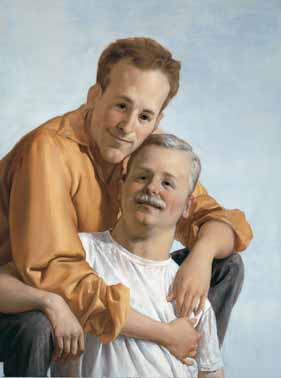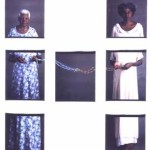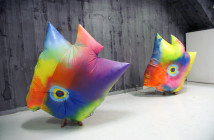Sensitivity awareness seemingly grew with the speed and ferocity of the internet bubble during 1990s. Not to say that the emotional bubble has since burst or that things have changed, but no one can deny that the last decade saw a dramatic spike in yoga class attendance, a more overt P.C. office culture, and the ongoing march of organic food set on conquering your refrigerator. The glow of prosperity frayed the harsh edges of modernism and brightened up the dinginess of postmodernism. Few cultures felt the shift more than the art world, where Identity Politics reigned with a soft fist. But perhaps something more fundamental than financial security and cultural awareness abetting the influx of self-portraiture, figuration, and such humanist images. The ICA’s latest exhibition not only highlights this palpable trend, but recasts it as a generational reassessment of art and human experience.
Getting Emotional, featuring an extensive display of biennial artists from the last 15 years, is centered on the premise that emotion (be it expression, reaction, experience) has re-entered art after a 50-year banishment.
According to the exhibition literature, which is both well-written and rich with sources and insights, many artists today are using emotion as either subject matter or meta-subject matter for their work. The trend is explained as a logical reaction to the Pop, Minimalist and Conceptual art movements from the 60s and 70s in which objectivity and criticality loomed large, and subjectivity and expression were scoffed at as the stuff of Sunday afternoon painters.
Curator Nicholas Baume posits that this renewed interest in expression and feelings is connected to a cultural-wide reassessment of emotion’s position within human knowledge and experience. Cartesian duality has been officially killed off by the numerous disciplines that Baume discusses, from neurology to the social sciences, indicating that “emotional intelligence” has found its way not only into the vocabulary of a school counselor but into the curatorial lexicon.
In order to navigate a visitor through such an enormous and amorphous topic, thankfully, the exhibition is divided into four sections and gallery areas: Bodily Sensation, Feelings Portrayed, Emotional Intimacy, and Emotion and Society. Bodily Sensations and Emotion and Society, featuring work that explores physical and group or cultural expression, are the more direct and immediately grabbing portions, since such art was clearly designed to engage and play on a viewer’s response. For instance, Chloe Piene’s projection, Blackmouth in Bodily Sensations, is a dramatic visualization of adolescent angst in the looming body of an 11-year old girl slugging through mud to the soundtrack of her slowed, animal-like groans. We are more than overwhelmed by this “child.” As a counter balance in the same area, Paul Pfeiffer’s small video loop of a basketball player yelling, Fragment of a Crucifixion (After Francis Bacon), looks like a distilled gem of pop culture expression. Meanwhile, the latter group, Emotion in Society, hits on key social issues that are difficult to ignore: the Israeli-Palestinian conflict, street riots, patriotism and its pitfalls, and even group euphoria in Andreas Gursky’s enormous photograph, May Day II.
In the remaining sections, Feelings Portrayed and Emotional Intimacy, “emotion” occurs within the parameters of the work and we are merely witnesses to another person’s expression, be it a couple or a single subject. It is in these moments that the exhibition can seem flat. It is not that the individual works are not good - in fact, the show is an exceptional collection of young, successful artists who are all producing smart work. It is that the topics become so broad that just about anything can find its way into the theme. Elizabeth Peyton’s wispy portraits, John Currin’s rich oil painting of two men, Ron Mueck’s virtuoso wax model of a naked mother and her newborn child are all iconic pieces in contemporary art. Though each piece inevitably reveals the obligatory emotional layer, however their inclusion in this show seems more impressive rather than necessary. There is a feeling in the galleries of a movie with too many stars – each competing for our attention.
Perhaps ultimately this subtle lack of cohesion is simply a result of the ICA’s unfortunate space. Low ceilings and cramped galleries are not the best showcase for any art, let alone large paintings that need space and light. Then again, a good show in an unfortunate space may eventually prove profitable for the ICA – after all what better way to promote a spectacular new building project than by exposing the limitations of the current residence!
- Maria Magdalena Campos-Pons, Replenishing, 2001.
- Ricky Swallow, And the Moment Will Come When Composure Returns (Decoy), 2002.
- John Currin, Two Guys, 2002.
Links:
Institute of Contemporary Art
"Getting Emotional" is on view May 18, 2005 - September 5, 2005 at The Institute of Contemporary Art.
All images are courtesy of the artist and The Institute of Contemporary Art.







